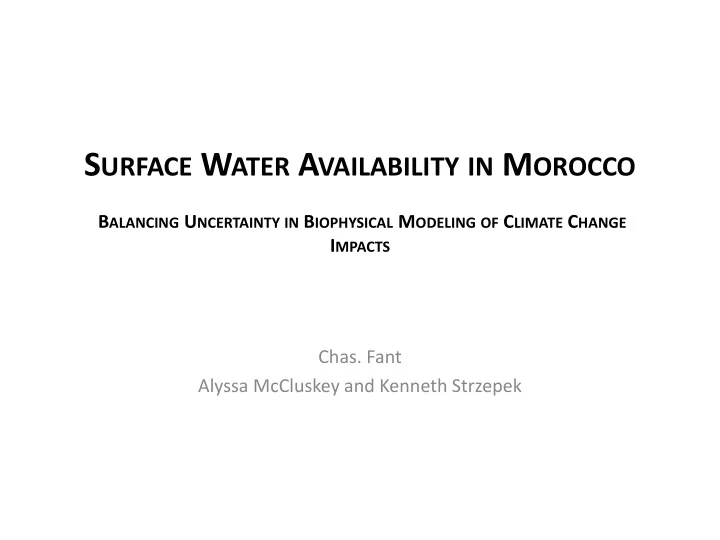

S URFACE W ATER A VAILABILITY IN M OROCCO B ALANCING U NCERTAINTY IN B IOPHYSICAL M ODELING OF C LIMATE C HANGE I MPACTS Chas. Fant Alyssa McCluskey and Kenneth Strzepek
Integrated Framework Global change (temperature, rainfall, fossil fuel prices) Rivers Sea level rise (runoff, streamflow) (land loss, salination) Flooding (frequency, severity) Infrastructure Energy Agriculture (roads, ports, houses) (hydropower) (food, exports) Local economy (growth, jobs, welfare, inequality)
Overview of CLIRUN-II Rainfall-runoff model • Focus on the impacts of changes in climate • Calibration / validation procedure to build base model • For the future, climate is adjusted •
Overview of CLIRUN-II Model Structure Input: • Temperature – Precipitation – PET – Output • Total runoff – Structure • Water enters system by rain and – snowmelt Two soil layers – Water exits the system by evaporation, – quick runoff and slow runoff
Basin delineation 16 basins with “measured” • stream flow 21 basins without measured • stream flow Natural vs. actual stream flow •
Climate Change Data Hadley Centre model • – Downscaled to 0.1 degree from 2.75 X 3.75 deg grids – 2 scenarios: A2 and B2 A suite of 56 GCM-SRES pairs • – 22 GCMs – 3 SRES scenarios: A2, A1b, and B1 GCM uncertainty • – Best at predicting long-term global mean changes
Climate Change Data GCM data GCM-Future [decade mean] GCM-Base [mean] 2010 - 2100 Apply to ‘measured’ base data 30 years of ‘Measured’ climate Change in Climate data monthly time series Climate used as input
Results Change in climate for a basin
Results Change in runoff for the Souss Basin
Results Change in runoff overview for Morocco
Conclusions The future is uncertain • GCMs are the most advanced tools currently available for estimating the • long-term effects of climate change Impact studies are more valuable if we understand the impacts in terms of • a range of possible outcomes
Recommend
More recommend